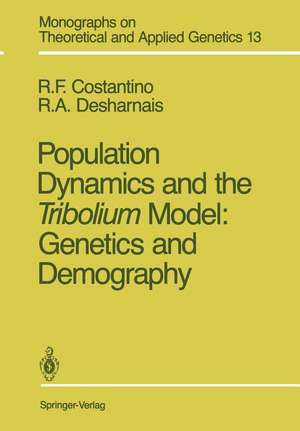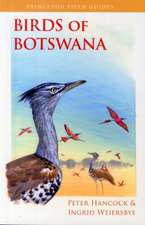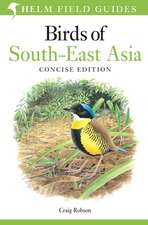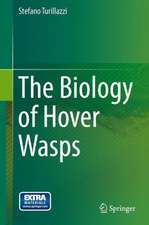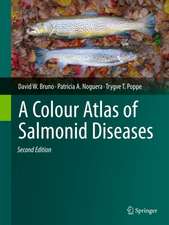Population Dynamics and the Tribolium Model: Genetics and Demography: Monographs on Theoretical and Applied Genetics, cartea 13
Autor Robert F. Costantino, Robert A. Desharnaisen Limba Engleză Paperback – 17 sep 2011
Din seria Monographs on Theoretical and Applied Genetics
- 20%
 Preț: 559.63 lei
Preț: 559.63 lei - 18%
 Preț: 985.38 lei
Preț: 985.38 lei -
 Preț: 383.71 lei
Preț: 383.71 lei - 20%
 Preț: 555.35 lei
Preț: 555.35 lei - 15%
 Preț: 644.30 lei
Preț: 644.30 lei - 15%
 Preț: 643.65 lei
Preț: 643.65 lei - 15%
 Preț: 640.06 lei
Preț: 640.06 lei - 15%
 Preț: 649.71 lei
Preț: 649.71 lei - 15%
 Preț: 639.41 lei
Preț: 639.41 lei -
 Preț: 387.20 lei
Preț: 387.20 lei - 15%
 Preț: 642.68 lei
Preț: 642.68 lei - 15%
 Preț: 639.25 lei
Preț: 639.25 lei - 15%
 Preț: 637.59 lei
Preț: 637.59 lei - 15%
 Preț: 636.30 lei
Preț: 636.30 lei - 15%
 Preț: 644.82 lei
Preț: 644.82 lei - 15%
 Preț: 648.42 lei
Preț: 648.42 lei - 15%
 Preț: 643.16 lei
Preț: 643.16 lei - 20%
 Preț: 558.52 lei
Preț: 558.52 lei - 15%
 Preț: 639.08 lei
Preț: 639.08 lei
Preț: 641.38 lei
Preț vechi: 754.56 lei
-15% Nou
Puncte Express: 962
Preț estimativ în valută:
122.74€ • 127.67$ • 101.33£
122.74€ • 127.67$ • 101.33£
Carte tipărită la comandă
Livrare economică 15-29 aprilie
Preluare comenzi: 021 569.72.76
Specificații
ISBN-13: 9781461278238
ISBN-10: 1461278236
Pagini: 276
Ilustrații: XII, 258 p.
Dimensiuni: 170 x 244 x 14 mm
Greutate: 0.45 kg
Ediția:Softcover reprint of the original 1st ed. 1991
Editura: Springer
Colecția Springer
Seria Monographs on Theoretical and Applied Genetics
Locul publicării:New York, NY, United States
ISBN-10: 1461278236
Pagini: 276
Ilustrații: XII, 258 p.
Dimensiuni: 170 x 244 x 14 mm
Greutate: 0.45 kg
Ediția:Softcover reprint of the original 1st ed. 1991
Editura: Springer
Colecția Springer
Seria Monographs on Theoretical and Applied Genetics
Locul publicării:New York, NY, United States
Public țintă
ResearchCuprins
1 Introduction.- 1.1 A Brief History of the Mathematics of Tribolium.- 2 Biology and Dynamics of Age Structure.- 2.1 Models for Age-Structured Populations.- 2.2 Life Stage Interactions.- 2.3 Parameterization.- 2.4 Experimental Data and Computer Simulations.- 2.5 Summary and Conclusions.- 2.6 Appendix.- 3 Demographic Oscillations.- 3.1 Egg-Larval Submodel.- 3.2 Analytical Results.- 3.3 Numerical Results.- 3.4 Biological Relevance.- 3.5 Summary and Conclusions.- 3.6 Appendix.- 4 Continuous Stochastic Models.- 4.1 Deterministic Model for Adult Numbers.- 4.2 Stochastic Model for Adult Numbers.- 4.3 Statistical Procedures.- 4.4 Applications.- 4.5 Stationary Time Series.- 4.6 Time-Dependent Gamma Distribution.- 4.7 Summary and Conclusions.- 5 Discrete Stochastic Models.- 5.1 Population Growth as a Birth-Death Process.- 5.2 Nonlinear Birth-Death Process for Tribolium.- 5.3 Linear Birth-Death Approximation.- 5.4 Application to Tribolium brevicornis.- 5.5 Summary and Conclusions.- 5.6 Appendix.- 6 Natural Selection.- 6.1 Ecological-Genetic Perspective.- 6.2 Density-Regulated Natural Selection.- 6.3 Experimental Results on the Corn Oil Sensitive Mutant.- 6.4 Summary and Conclusions.- 7 Genetic Disequilibrium.- 7.1 An Entropy Measure of Genetic Disequilibrium.- 7.2 Rate of Genetic Adaptation.- 7.3 Density-Independent Population Growth.- 7.4 Density-Dependent Population Growth.- 7.5 Extensions to the Theory.- 7.6 Summary and Conclusions.- 8 Two Interacting Species.- 8.1 Competition as an Adult-Immature Interaction.- 8.2 Two Cannibalistic Species.- 8.3 An Inhibiting Species with a Cannibalistic Species.- 8.4 Two Inhibiting Species.- 8.5 Summary and Conclusions.- 9 Dynamics and the Tribolium Model.- 9.1 Demography.- 9.2 Stochasticity.- 9.3 Natural Selection.- 9.3.1 Natural Selection and Age Structure.- 9.4 Species Interactions.- 9.5 Summary and Conclusions.- References.- Author Index.
